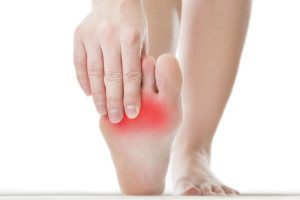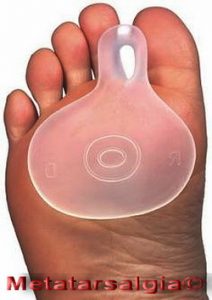
Metatarsalgia
Metatarsalgia
Some questions answered
- What is metatarsalgia?
- What causes metatarsalgia?
- Can it be prevented?
- I have pain in the ball of my foot. What can I do about it?
- When shoud I obtain professional advice?
- What tests may be done?
- What can be done about it?
- Do I need an operation?
What is metatarsalgia?
Metatarsalgia is pain in the ball of the foot. It is usually felt in the sole of the foot and sometimes feels like “walking on pebbles”. Other people feel a more diffuse vague pain, ache or burning. Some people have trouble around only one or two toes, others have it throughout one or both feet.

What causes metatarsalgia?
Anything which puts extra stress on the front of the foot can cause metatarsalgia. Common examples are:
- Being overweight
- High-heeled shoes
- Certain foot shapes such as a high-arched “cavus” foot in which the bones in the front of the foot (metatarsals) point down into the sole to an excessive extent, or a long metatarsal bone which takes extra pressure
- Claw or hammer toes which press the metatarsals down towards the ground
- Stiff ankle which cannot be drawn up to right angles with the leg but points the foot down to the ground
A bunion or arthritis in the big toe can weaken the big toe and throw extra stress onto the ball of the foot. This can also happen after an operation on the big toe, such as a bunion correction.
A stretched or irritated nerve in the ball of the foot (interdigital neuroma) or behind the ankle (tarsal tunnel syndrome) can produce pain in the ball of the foot. Diabetes can also produce problems with the small nerves in the foot leading to a burning pain.
Athletes or walkers occasionally get stress fractures of the metatarsal bones.
Arthritis, gout or inflammation of the joints in the ball of the foot (metatarso-phalangeal joints) can produce local pain.
Can it be prevented?
As you can see from the list above, some causes of metatarsalgia can be prevented by :
- Reduce weight
- Avoid wearing high-heeled tight shoes
- Not allowing the ankle to become stiff, especially after a sprain or other injury
- Getting treatment for diabetes, gout or arthritis
However, many causes of metatarsalgia just happen and cannot be prevented
I have pain in the ball of my foot. What can I do about it?
Try to take the pressure off your feet as far as possible.
- Rest with your feet up after periods of standing or walking
- Keep your weight at the right level for your height and build
- Wear comfortable shoes with a small heel and plenty of room for your feet
Other things you could try:
- Exercise your ankle and stretch your Achilles tendon
- Medication like Paracetamol
- Metatarsal insole Silicone pad

When should I obtain professional advice?
If none of these simple measures help your pain and this is interfering with your normal activities, it is worth consulting your Orthopaedic Foot and Ankle doctor. They may be able to help you, and at times further tests or an operation is thought necessary.
What tests may be done?
Many causes of metatarsalgia can be diagnosed by listening carefully to your complaints and examining you carefully, especially your foot. A simple test of the urine will check for early diabetes. Blood tests for inflammation, arthritis, diabetes or gout may be useful. An Xray of your foot may show a problem in the bones or joints.
Most people will not need any other tests. However in a few people, more complicated tests such as a bone scan, magnetic resonance (MR) scan, foot pressure measurements or nerve tests may be helpful in diagnosing a difficult problem.
Even after tests the cause of your problem may not be known for certain.
What can be done about it?
The simple measures outlined above will be re-emphasised by your professional adviser, especially about weight and shoes! Treatment can be offered for any disease such as diabetes, gout or arthritis. An insole to share the weight more evenly about your foot may be prescribed. An injection of steroid into an inflamed joint or around an irritated nerve may reduce inflammation and pain. However caution is to be taken for not to take repeated steroid injection as it might be more harmful. Exercises may improve stiffness.
Do I need an operation?
The great majority of people with metatarsalgia will be helped by the measures outlined above. In a few people an operation may help:
- Release of a trapped nerve or removal of an irritated nerve
- Straightening of hammer or claw toes to take pressure off the metatarsal bones
- Reshaping or shortening prominent metatarsal bones
ALSO READ


How To Choose The Ideal Paper Writing Service
Posted On 24 May 2023
When you use a paper writing service, then you are picking a company that's devoted to your needs. They are…
APA Live Chat – The Way I Could Write My Paper?
Posted On 8 May 2023
If you've got a big test coming up and you need to have it done on time, and then you…
How to Write My Paper Cheaply
Posted On 7 May 2023
There are many ways to compose my paper inexpensively. In fact, some approaches can actually save money for the writer.…
Posted On 4 May 2023
Have Fun and Enjoy a Fun Way to Enjoy your time at home by playing free slots at the casino…
How to Write My Essay About Writing Sample Papers
Posted On 23 Apr 2023
Are you worried about how to write my own article? I understand, it's somewhat intimidating when you first begin learning…

College Application Essay Writing Service Voucher Reddit.com
Posted On 12 Apr 2023
This will suggest having a apparent being familiar with of the supply material or the subject and sticking shut to…

Quality Custom Essay Writing Service Reddit.com
Posted On 12 Apr 2023
Many universities present distinctive deals with savings which you could uncover fascinating. This way you will hardly ever free the…
Reddit Custom Essay Writing Service For Cheap
Posted On 12 Apr 2023
The Looming Questions: Will the reserve be a accomplishment or not? How considerably would this maximize your composing money? Now,…
Reddit Essay Writing Service Atlanta Ga
Posted On 11 Apr 2023
Pretty much as vital as firm any time you are producing essays, is concept generation. Nothing at all will kill…
Reddit.com Persuasive Essay Writing Service Online
Posted On 11 Apr 2023
As aspect of the organizing for faculty admissions, a timeline ought to be established in progress. Consequently, your site visitors…